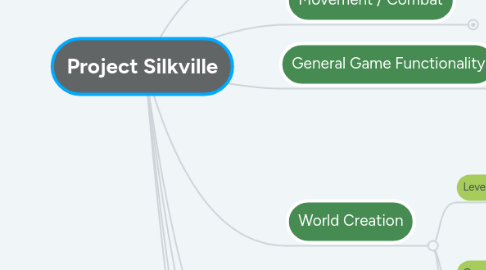
1. Game Vision
1.1. Art Direction
1.1.1. Art Concept
1.1.2. Target Game Screen
1.1.3. ADD Created
1.2. Player Experience
1.2.1. Mood / Tone / Feeling of the game
1.2.2. Key Design Pillars for the game
1.3. Product Remarkability
1.3.1. Single point of motivation for the game
1.3.2. Aspect of the game which will be remarkable
1.4. High Level Story
1.4.1. Who is the player
1.4.2. What is the player trying to do
1.4.3. What stands against the player
1.5. Tech Stack
1.5.1. Tools and Limitations for the game
2. Movement / Combat
2.1. Player Character Movement
2.1.1. Assets
2.1.1.1. Player Character Type 1
2.1.1.1.1. Animation
2.1.1.1.2. Character Model
2.1.1.1.3. Visual Effects
2.1.1.1.4. Audio
2.1.2. Functionality
2.1.2.1. Path-finding / Collision
2.1.2.2. Animation Blending
2.1.2.3. Controls are implemented and Tuneable
2.1.2.3.1. Mouse / Keyboard
2.1.2.3.2. Game Pad Controller
2.1.2.4. Camera Placement and Tuneing
2.1.2.5. Variable Exposed
2.1.2.5.1. Player Movement Speed
2.1.2.5.2. Camera Distance
2.1.2.5.3. Camera Angle
2.2. Combat
2.2.1. Assets
2.2.1.1. Enemy Type 1
2.2.1.2. UI Assets
2.2.1.3. Visual Effects
2.2.2. Functionality
2.2.2.1. Basic Attack
2.2.2.1.1. Controls to attack
2.2.2.1.2. Melee Attack
2.2.2.1.3. Ranged Attack
2.2.2.1.4. Damage Calculation
2.2.2.1.5. HP Reduction
2.2.2.1.6. Weapon Modifiers
2.2.2.1.7. Armor Modifiers
2.2.2.1.8. Buffs or Debuffs Calculations
2.2.2.2. Special Attacks
2.2.2.3. Enemy AI
2.3. Character Stats
2.4. Enemies
2.5. Character Progression / Leveling Up
2.6. Special Abilities
3. General Game Functionality
4. World Creation
4.1. Level Creation
4.1.1. Assets
4.1.1.1. Environment Models for World
4.1.1.2. Props
4.1.1.3. Visual Effects
4.1.2. Functionality
